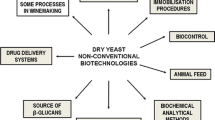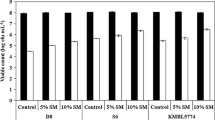Abstract
The effects of industrial storage on the changes of the cell viability and the activities of intracellular alcohol dehydrogenase (ADH) and glucose-6-phosphate dehydrogenase (G6PDH) in brewer’s yeast, and the corresponding capacity for the bioconversion of ethyl-3-oxobutanoate (EOB) to ethyl (S)-3-hydroxybutanoate ((S)-EHB), were investigated. The viability of fresh brewer’s yeast cells stored in industrial circulating cooling water at 1–2°C showed 4 and 15% drop after the storage of 7 and 15 days, respectively, after which cells died rapidly. The pretreatment of the stored brewer’s yeast cells by washing and screening significantly enhanced cell viability during industrial storage. The intracellular levels of ADH and G6PDH after permeabilization of these stored cells with cetyltrimetylammonium bromide (CTAB) were much higher, which showed only slight decrease within 2 weeks during the industrial storage. When the stored cells after the permeabilization treatment was used as the biocatalyst at 90–120 g/L, EOB was converted almost completely into enantiopure (S)-EHB with an enantiomeric excess (ee) more than 99% and a yield of over 96%, by fed-batch bioconversion of 560 mM EOB within 6 h.









Similar content being viewed by others
References
Rosen TC, Daussmann T, Stohrer J (2004) Bioreduction forms optically active 3-hydroxyesters. Spec Chem Mag 24:39–40
Albuquerque PM, Witt MA, Stambuk BU, Nascimento MG (2007) Influence of sugars on enantioselective reduction using Saccharomyces cerevisiae in organic solvent. Process Biochem 42(2):141–147. doi:10.1016/j.procbio.2006.07.034
Kanda T, Miyata N, Fukui T, Kawamoto T, Tanaka A (1998) Doubly entrapped baker’s yeast survives during the long-term stereoselective reduction of ethyl 3-oxobutanoate in an organic solvent. Appl Microbiol Biotechnol 49:377–381. doi:10.1007/s002530051185
Chin-Joe I, Nelisse PM, Straathof AJJ, Jongejan JA, Pronk JT, Heijnen JJ (2000) Hydrolytic activity in baker’s yeast limits the yield of asymmetric 3-oxo ester reduction. Biotechnol Bioeng 69:370–376. doi:10.1002/1097-0290(20000820)69:4<370::AID-BIT3>3.0.CO;2-B
Chin-Joe I, Straathof AJJ, Pronk JT, Jongejan JA, Heijnen JJ (2002) Effect of high product concentration in a dual fed-batch asymmetric 3-oxo ester reduction by baker’s yeast. Biocatal Biotransformation 20:337–345. doi:10.1080/10242420290031370
Buque EM, Chin-Joe I, Straathof AJJ, Jongejan JA, Heijnen JJ (2002) Immobilization affects the rate and enantioselectivity of 3-oxo ester reduction by baker’s yeast. Enzyme Microb Technol 31:656–664. doi:10.1016/S0141-0229(02)00161-8
Chin-Joe I, Haberland J, Straathof AJJ, Jongejan JA, Liese A, Heijnen JJ (2002) Reduction of ethyl 3-oxobutanoate using non-growing baker’s yeast in a continuously operated reactor with cell retention. Enzyme Microb Technol 31(5):665–672. doi:10.1016/S0141-0229(02)00165-5
Bonora GM, Drioli S, Forzato C, Nitti P, Pitacco G (2005) Baker’s yeast reduction of PEG-linked acetoacetate. Lett Org Chem 2:89–91. doi:10.2174/1570178053400135
Carnell AJ, Head R, Bassett D, Schneider M (2004) Efficient large scale stereoinversion of (R)-ethyl 3-hydroxybutyrate. Tetrahedr Asym 15(5):821–825. doi:10.1016/j.tetasy.2003.12.005
Johanson T, Katz M, Gorwa-Grauslund MF (2005) Strain engineering for stereoselective bioreduction of dicarbonyl compounds by yeast reductases. FEMS Yeast Res 5(6–7):513–525. doi:10.1016/j.femsyr.2004.12.006
Zhang J, Witholt B, Li Z (2006) Coupling of permeabilized microorganisms for efficient enantioselective reduction of ketone with cofactor recycling. Chem Commun 4:398–400
Zhang J, Witholt B, Li Z (2006) Efficient NADPH Recycling in enantioselective bioreduction of a ketone with permeabilized cells of a microorganism containing a ketoreductase and a glucose 6-phosphate dehydrogenase. Adv Synth Catal 348:429–433. doi:10.1002/adsc.200505439
Yu M-A, Wei Y-M, Jiang L, Xiao-bing Z, Qi W (2007) Bioconversion of ethyl 4-chloro-3-oxobutanoate to ethyl(R)-4-chloro-3- hydroxybutanoate by a permeabilized fresh brewer’s yeast cells in the presence of allyl bromide. J Ind Microbiol Biotechnol 34(2):151–156. doi:10.1007/s10295-006-0179-z
Powell CD, Van Zandycke SM, Quain DE, Smart KA (2000) Replicative ageing and scenescence in Saccharomyces cerevisiae and the impact on brewing. Ferm Microbiol 146:1023–1034
Gowda LR, Joshi MS, Bhat SG (1988) In situ assay of intracellular enzyme of yeast (Kluyveromyces tragilis) by digitonin permeabilization of cell membrane. Anal Biochem 175:531–536. doi:10.1016/0003-2697(88)90579-9
Acknowledgments
This work was supported by the special fund of three items of expenditure on science and technology department of Central District in ChongQing. We also thank the Chongqing Medical University for partial financial support of this work.
Author information
Authors and Affiliations
Corresponding author
Electronic supplementary material
Below is the link to the electronic supplementary material.
Rights and permissions
About this article
Cite this article
Yu, MA., Hou, Y., Gong, GH. et al. Effects of industrial storage on the bioreduction capacity of brewer’s yeast. J Ind Microbiol Biotechnol 36, 157–162 (2009). https://doi.org/10.1007/s10295-008-0483-x
Received:
Accepted:
Published:
Issue Date:
DOI: https://doi.org/10.1007/s10295-008-0483-x




